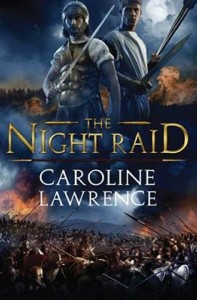
The Night Raid is another of Caroline Lawrence’s retellings of stories from Virgil’s Aeneid for Barrington Stoke.
After I reviewed Queen of the Silver Arrow a few days ago, Ms Lawrence was kind enough to send me a copy of The Night Raid for review.
While Queen of the Silver Arrow is taken mostly from Book XI of the Aeneid, The Night Raid is the story of the Trojan warriors, Nisus and Euryalus, from Book IX. Nisus is a young man, not much more than a boy, and Euryalus (referred to in The Night Raid as Rye for short) is still a boy, barely into his teens. The two are inseparable, so when their Trojan camp is besieged by Turnus and his Italian warriors, and Nisus comes up with a plan to sneak through the encircling enemies at night to go for help, Rye insists on going with him.
In the Aeneid, they fall on their enemies unaware, kill several of them without raising the alarm, but are pursued and killed by Turnus and his men. “fortunati ambo,” says Virgil in the poem. “Fortunate pair! If my songs can do anything, there will never come a day when you are erased from the memory of time.” We might quibble about being killed and having your head stuck on a spike being “fortunate”, but we’re still reading and writing about them, so Virgil was right in at least one respect.
The fate of the pair isn’t a spoiler, by the way. While the majority of this book is narrated by Nisus, the prologue, an intermission, and the epilogue are narrated by Euryalus – after his death. The book begins with the words: “I was young when they killed me. Just a teenager.”
Much of the main narrative is taken straight from Book IX, with some scenes (such as the death of Euryalus, or when they tell Aeneas’ son Ascanius about their plan) following the original poem very closely indeed. Lawrence also brings in the earlier mention of the pair from Book V – the funeral games of Aeneas’ father Anchises – and provides us with an invented back story of how the boys met during the sacking of Troy. Virgil painted these characters with broad strokes, and Lawrence fills in the details nicely. The action of the raid itself is fast and frantic, and the fate of the friends suitably heart-breaking – perhaps all the more so because you know it’s coming.
I enjoyed the way Lawrence tied in their story with Virgil’s “fortunati ambo” statement, too.
As with Queen of the Silver Arrow, because it’s designed to be dyslexia-friendly, this is a short book with simple language that covers more mature subject matter – war and death and literary immortality – than you might expect from its size. The cover – by Steve Stone – does hint at this; with its dark and warlike atmosphere, it’s more like a Simon Scarrow or Ben Kane cover than the books that would live on the 8-12 shelf of your local bookshop.
I’d definitely like to see more in this series. The Aeneid is a rich source of stories, many of which could be turned into separate books. How about Aeneas and Dido? After two books where the protagonists meet unpleasant fates, we could do with a feel-good love story. Oh. Wait…